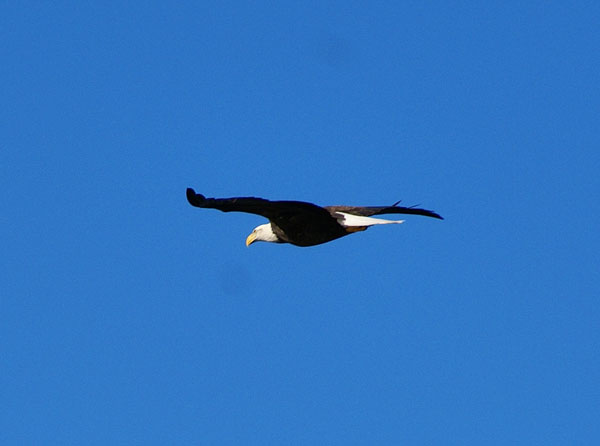Quote:
Originally Posted by Pineedles

All I could think of looking at these pictures was, THE UNITED STATES OF AMERICA! FREE AND STRONG! Great pics Don!
|
I agree!
As an admirer of bird behavior—birds in general—and a lifelong student of Flight, I find the last photo fascinating:
 1) Curved
1) Curved at the Eagle's left wingtip, you can see what are called the "
primary feathers":
Each primary feather (of a dozen or so, per wing) is shaped in cross-section like an airplane's wing. If just one of those is lost, there is a serious loss in "lift" for the bird—and usually at the feather's root—some loss of blood!
2) Turbulence and the wing:
If you have leaned over the porch to shake out a carpet "runner", you can see a similar effect when an Eagle's wing hits turbulence: the "ripple" caused by turbulence will carry
across the wing in the exact-same way.

Just remarkable!
 3)
3) At the right wing, you can see a few feathers lifted.
Although I haven't researched it as yet, I'm fairly certain that
those few feathers correspond to a "stall-warning" for light aircraft.
(And that the bird can sense a "stall"
through those feathers).
Those lifted feathers are most easily seen in our largest Winnipesaukee birds—like the
Great Blue Heron—just as one alights after a deliberate "stall" near the shoreline.
4) This photo most likely has captured the wing in "soar" mode.
The dead-straight-across appearance means that this bird (plus the Eastern
Golden Eagle) can be identified from two miles away—
with the unaided eye!  (Though not intended to be a "plug" for kayaking, all the above are best seen from such slow-moving watercraft, or a watercraft not moving at all—like too-often—my sailboat).
(Though not intended to be a "plug" for kayaking, all the above are best seen from such slow-moving watercraft, or a watercraft not moving at all—like too-often—my sailboat). 